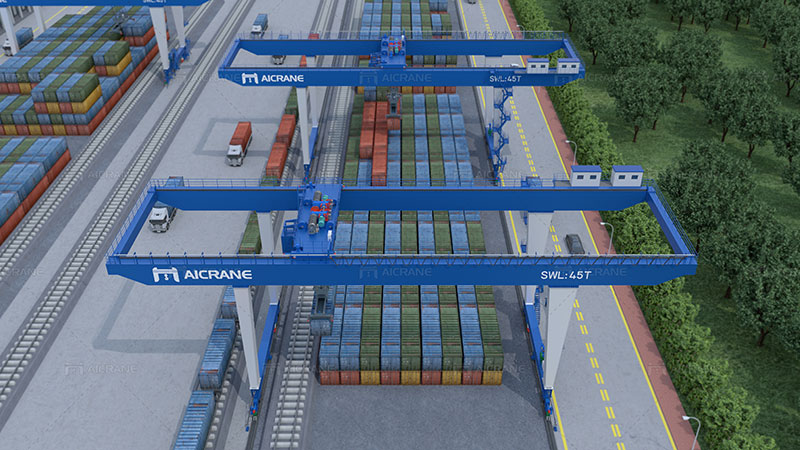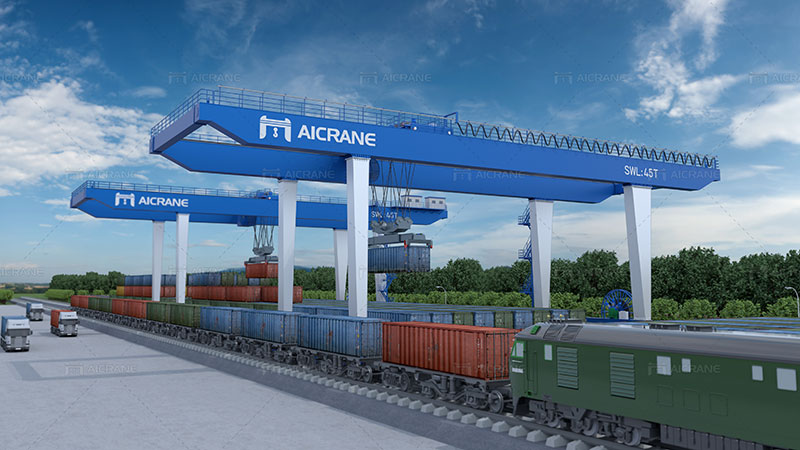Rail-mounted gantry cranes (RMGs) are critical pieces of equipment in various industries, including shipping, logistics, and manufacturing. These versatile cranes are used for handling heavy loads and containers in container terminals and warehouses. To make an informed decision when acquiring an RMG, it’s essential to understand their specifications. In this article, we’ll delve into the key specifications of rail-mounted gantry cranes to help you select the right equipment for your specific needs.

Capacity and Span
The first and most fundamental specification to consider when evaluating an RMG container gantry crane is its lifting capacity. RMGs are designed to handle a wide range of loads, and their capacity can vary significantly. RMGs typically range from small units with capacities of 20-40 tons to larger cranes capable of lifting over 100 tons.
When determining the required capacity, consider your application’s maximum load weight and any future growth in load sizes. It’s crucial to choose an RMG that can comfortably handle your current and projected requirements.
The span of an RMG refers to the distance between the crane’s rails. Span length varies depending on the layout of your facility and the size of the area you need to cover. Manufacturers offer various span options to suit different operational needs, and custom spans can often be accommodated to fit unique layouts.
Lifting Height
The lifting height of an RMG crane is another critical specification. It defines how high the crane can lift loads above the ground or the containers it’s handling. RMGs are designed to work efficiently in container terminals, stacking containers several levels high. Lifting heights for RMGs typically range from 15 meters (50 feet) to 30 meters (100 feet) or more.
When determining the required lifting height, consider the maximum stacking requirements of your facility. Ensure that the RMG you choose can handle the vertical space available and any future expansions or requirements.

Outreach
Outreach, also known as the outreach span, is a crucial rail mounted gantry crane specification. It refers to the horizontal distance the crane can reach from its rail centerline. Outreach is essential for reaching containers or loads in various positions within a storage yard or along a quay.
RMG cranes offer different outreach options to accommodate different layouts and operational needs. Shorter outreach cranes are suitable for compact storage yards, while longer outreach cranes are ideal for reaching containers positioned farther away.
Crane Speeds
The efficiency of RMG operations depends significantly on crane speed. Key speed specifications to consider include:
- Hoisting Speed: This refers to how quickly the RMG can raise or lower a load. Faster hoisting speeds can enhance productivity, especially in busy container terminals.
- Trolley Travel Speed: The trolley is responsible for moving the load horizontally along the crane’s gantry structure. Faster trolley travel speeds can reduce cycle times.
- Gantry Travel Speed: Gantry travel speed determines how quickly the entire crane can move along the rails. Higher gantry travel speeds can improve overall operational efficiency.
- The optimal speeds depend on your specific operational requirements and workflow. Carefully assess the required speeds to ensure your RMG crane meets your productivity goals.
Control System
RMG cranes can be equipped with advanced control systems that enhance precision and safety. These systems can include:
- Anti-sway technology to minimize load sway during lifting and positioning.
- Collision avoidance systems to prevent accidents.
- Remote monitoring and diagnostics for real-time data and maintenance alerts.
- Choose an RMG crane with a control system that aligns with your operational needs and safety standards.
Safety Features
Safety is paramount in any material handling operation. RMG cranes should come equipped with a range of safety features, including:
- Load limit and overload protection systems to prevent excessive loads.
- Emergency stop buttons for immediate shutdown in case of emergencies.
- Travel limit switches to prevent the crane from traveling beyond set limits.
- Collision avoidance systems to avoid accidents with other equipment or structures.
- Make sure the RMG crane you select meets or exceeds industry safety standards and regulations.
Environmental Considerations
Environmental factors can influence your choice of a gantry crane. For instance, if your facility is located in a coastal area with high humidity or saltwater exposure, you may need corrosion-resistant materials and coatings.
Additionally, consider energy efficiency. Some RMG cranes are equipped with regenerative drives and energy-saving features, reducing operational costs and environmental impact.
Conclusion
Choosing the right rail-mounted gantry crane requires a thorough understanding of its specifications and how they align with your operational needs. Whether you’re working in a container terminal, warehouse, or manufacturing facility, assessing factors such as capacity, span, lifting height, outreach, crane speeds, control systems, safety features, and environmental considerations is essential.
By carefully evaluating these specifications and working with reputable manufacturers and suppliers, you can ensure that the RMG crane you select not only meets your immediate requirements but also provides a reliable and efficient solution for your material handling needs, contributing to the overall success of your operations.
